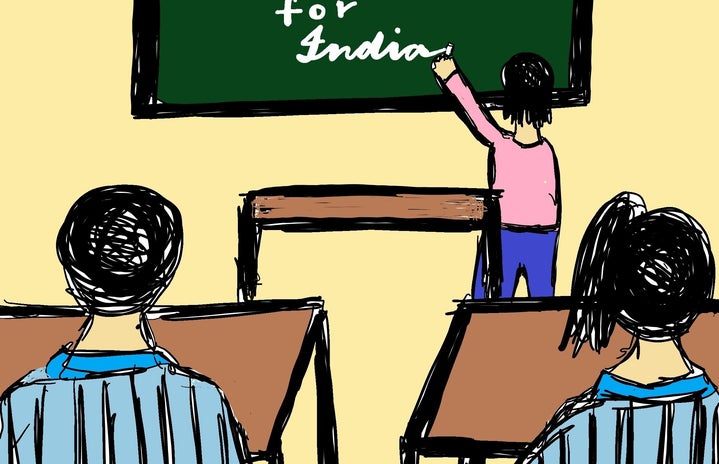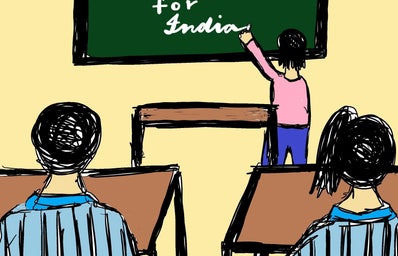Edited by Aneesha Chandra
This summer, I got to sit on the other side of the desk. The side where you have twenty or so eyes trailing you; the side filled with dust that falls from the chalk; the side piled with books to aid you, and the numerous worksheets of students. This summer, I became a teacher. It was an exciting prospect when first put forth, but little did I realize the amount of hard work and dedication that goes into such a job.
Teach for India — the organization that gave me this opportunity — really taught me a lot, not only about the prevailing education crisis, invisible to the people safe from it, but also about myself. I understood the importance of a teacher, and how impressionable a child’s mind can be. I learnt from the children themselves that nothing is as bad as it seems and to really be happy with what you have — even if it isn’t always easy. I have enjoyed myself immensely and couldn’t have asked for a better summer experience.
I was assigned an English class, somewhat like the movie English Vinglish, where I had to help the children improve their spoken and written English, and their reading ability. We played the games ‘Two Truths and a Lie’, ‘I Spy’, and a game of retrospection, where I showed them some pictures and they had to tell me what they thought of them. We also did some reading practice through simple, fun-filled tongue twisters, but only a handful of students volunteered to read. Based on these games, you would assume I was teaching a younger batch of 2nd and 3rd graders. No. I was teaching a batch of 8th and 9th graders. I realized that the issue is not just about English, but about building their confidence, their belief in trying, and their desire to learn.
This class really opened my eyes to the education crisis that I first heard of during my orientation day at Teach for India. What we normally take for granted is what is encompassed as a deprivation in the Ed crisis. Access to basic health and education facilities tops the chart. Then follows the availability of good teachers, not only to teach the children, but also for support and welfare. Infrastructural problems are plentiful, at schools and at home. Further, there is the inability to deploy basic resources, such as books, for the enhancement of student education. Simple curriculum formation and assessment methods are lacking in rigor and quality. All of this sums up to poor quality of education and a further widening of the gap — the Education Crisis. No wonder a majority of students dropout of school, trying to find jobs, knowing that they will be in the same place with or without a degree.
The team at Teach for India aims to tackle this inequality. The organization was started by Ms. Shaheen Mistri, Founder & CEO, with the vision that “One day all students will attain excellent education”. Teach for India is part of a bigger global committee, Teach for All, which started out with Teach for America. Teach for India has become a symbol of hope for many children across India, who just want to learn and live their dreams. They intervene in government schools that are understaffed, lack resources, and are not performing well.
Started in 2009, Teach for India has grown over the years and is now present in seven major cities across India. The balance between scale and depth is the reason why they haven’t expanded further to smaller towns and villages. When I asked Anannya Rajagopalan — Associate, Human Resources, Teach for India — about how they maintain that balance, she said that it is a dilemma they faced constantly: whether they should expand and reduce depth and quality of education or maintain depth and halt the expansion. It was a tough call, but they realized that depth was important to achieve their dream of holistic education. You have to be willing to let go of one of the others as it is very hard to balance the two. They had to make peace with being smaller players but holistic education providers.
Anannya said that, to them, holistic education was synonymous with excellent education, but there is no definite meaning to the term holistic; it keeps expanding every day. They work towards not only educational attainments, but also values, manners, extracurriculars and more — a long-term plan. Their idea is that the children must experience the learning. They do not believe in telling them what is right or wrong, but to be more accepting of everyone’s views,to accept that everyone is different and that you can’t force someone to be like you. This is integrated learning — you can touch every subject in one class, bringing in everyone to participate and take charge of the topic. She said that as an educator, their job is to give the children all sides to a topic and let them decide what they want to believe in. Their main efforts are toward providing the children with an equal fighting chance in the real world.
Teach for India believes that this form of excellent education can be attained through strong leadership — be it through teachers, principals ,or children. Anannya mentioned that their motto is “teaching is leadership is equal to leadership is teaching.” They try to create curriculum and interventions to enable enhancement of leadership. The change that leadership brings about need not be measured, it can be seen in the way the student and the teachers grow and learn. But a leader is not one person. It is a community of leaders, for only then can change be brought about.
One touching story of leadership was in 2009, when the organization first started out. When I asked Anannya about it, she told me that the teachers of that time wanted to figure out how to combine the expressive arts with learning, to help the students improve their spoken English, communication, public speaking and confidence and to see how it impacts the classroom learning. So, they came up with a Broadway style musical called Maya that focused on integrating academic achievement with values,mindsets,exposure, and access. At the end of this beautiful show, most students who had trouble speaking English became better orators, all their shyness evaporated into thin air.
A small YouTube search led me to the inspiring story of Priyanka, a student of Maya, who went from being a shy girl from a single parent family in Pune, to being able to stand up for herself. She convinced her mother not to get her married at 18 and instead went to study at the United World College in Italy. She started an initiative called Bridging the Gap, a project in student leadership aimed at reducing the wide gap between students like her and the rest of the world. She believed that Maya was not just a show, but a way of bringing themselves up and spreading their light.
Teach for India has done some splendid work in ensuring that the children have a life that they deserve and want. But sadly, Anannya let on, even after all their efforts, these children have to continue fighting for a place in the world. The aim of the organization is to give the children an equal chance in the real world, but many a time, it doesn’t work out. When the students graduate after completing 10th grade, many of them struggle outside the Teach for India ecosystem due to the, still prevailing, wide equality gap. Many are forced to drop out of further studies. This is one of the grim realities that the organization is forced to face.
Be that as it may, Teach for India has given children across India the chance to dream on, to never give up, and to fight for who they want to be. It has given the shy child a voice, the aspiring child a chance, and to all the children, hope. It has also taught the children to love themselves and taught us, the teachers, to never give up and that every effort is worth its while.
One of the most exciting and reflection-filled summers I have had!



